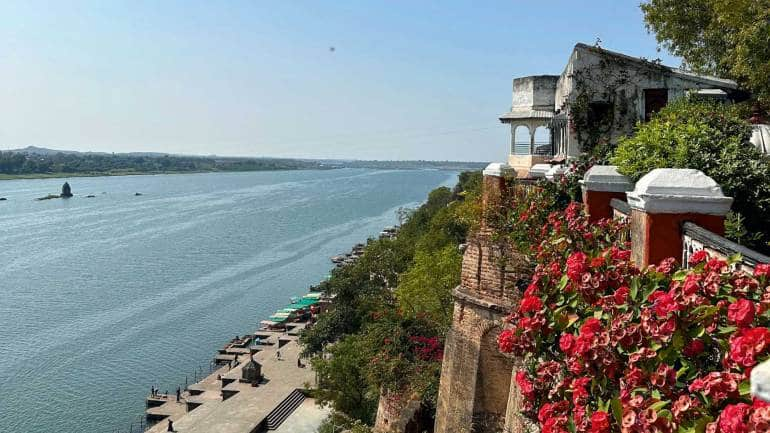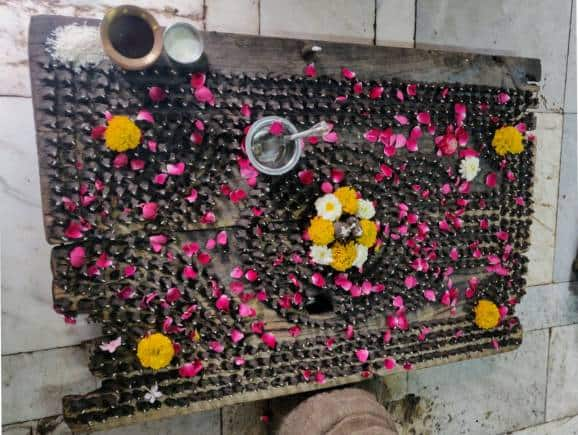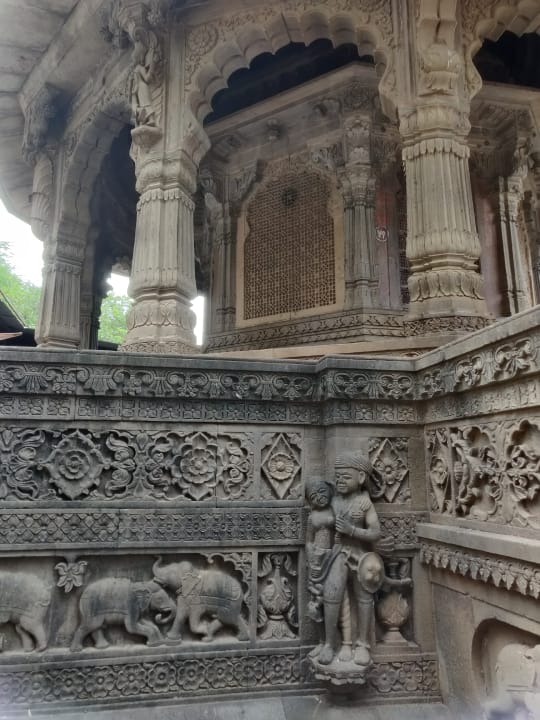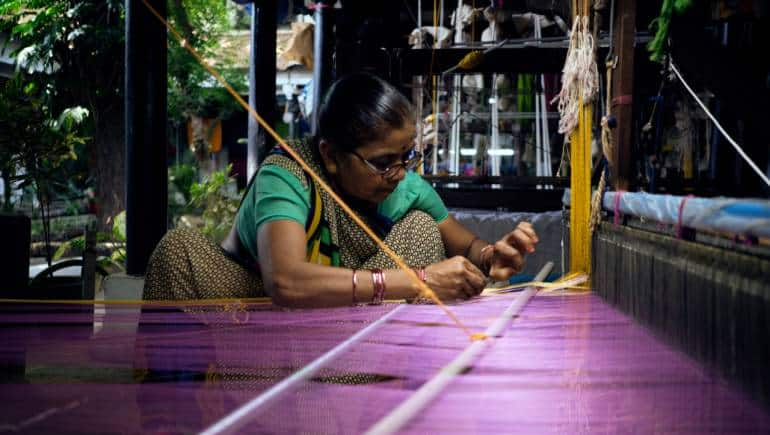



The quintessential Maheshwar experience is the sum of many parts. At its heart is the Ahilya Palace and the Narmada river, closely linked to the legend of Maharani Ahilyabai Holkar, a Maratha married into the Holkar dynasty. Unique to Maheshwar is the continued involvement of the Holkar family with the community; both are stakeholders in preserving the destination’s charm and heritage. Depending on your interests, it is possible to do two-three of these experiences over a long weekend:
Experience 1: Fort Palace
Before Ahilyabai’s reign, Maheshwar was a pilgrimage town. She shifted the Holkar dynasty’s capital from Indore to Maheshwar in 1765, after the death of her husband Khande Rao Holkar. She established dharmshalas, temples, markets and the Rajwada - her seat of governance and her residence, which is today known as the Ahilya Fort.
 The Rajwada is constructed from solid stone in the Maratha architectural style.
The Rajwada is constructed from solid stone in the Maratha architectural style.
As we stroll through the narrow lanes of the bazaar, bordered by artisan homes and shops selling Maheshwari sarees, my guide Parvez Quereshi says: “She (Ahilyabai) extended invitations to weavers from Surat and Malwa, requesting them to relocate to Maheshwar and create 9-yard sarees intended as gifts for royal guests and family. This marked the inception of the Maheshwari saree.”
Perched on a cliff overlooking the river, Ahilya Fort remains the focal point in a town where time flows as languidly as the gentle Narmada. This is where the web series, A Suitable Boy, based on Vikram Seth’s eponymous book was made.
The Rajwada, constructed from solid stone in the Maratha architectural style, boasts features such as elaborate gateways, domed structures, temples, courtyards, gardens, organic vegetable farms, pavilions, water bodies, and an entire ecosystem that sustained a thriving town within its fortified walls. Today, Maheshwar has expanded in all directions as it continues to evolve.
Archaeological Survey of India excavations reveal that the fort’s walls date back over a millennium, yet an exact date remains elusive. While certain historians attribute the fort’s initial construction to the Paramara ruler Munj Deo, others trace its origins back to the Mauryan period, around the 4th century BC. The current architectural form is ascribed to Malhar Rao Holkar, who won Maheshwar in 1733 and enlarged the existing fort.
Within the fortress walls are homes and shops of residents. Ahilya Fort is divided into two distinct sections. The Rajwada, the seat of power for the Malwa Kingdom, where Maharani Ahilyabai made decisions and met her subjects, has now been transformed into a museum. The wooden structure stands on a stone platform, flanked by statues of an elephant, horse and bull, all intricately carved from a single block of stone. Artefacts such as the queen’s palki, the gaddi on which she sat and held court, and the regal symbols of the state narrate the story of a kingdom that was a formidable ally of the mighty Marathas.
In the serene and dimly lit ancient temple devoted to Lord Shiva, the principal deity of Maheshwar, situated within the Rajwada, a daily ritual unfolds. Each morning, 11 priests, descendants of those who have long served the temple, shape thousands of miniature shivlings using mud gathered from the banks of the Narmada. This ritual, known as Lingarchan Puja, was originally initiated by Ahilyabai herself, and involves submerging these miniature shivlings into the river.
 Lingarchan Puja with miniature Lingams made from river silt.
Lingarchan Puja with miniature Lingams made from river silt.
In 2000, Ahilya Wada, the queen's residence, and the fort palace underwent extensive restoration efforts led by Prince Richard Holkar, son of the last Maharaja of Indore. Prince Richard collaborated with Mysuru-based architect Ravi Gundu Rao, known for his expertise in restoring stone sculptures. Today, a portion of this revitalized complex serves as a heritage hotel, managed by Yeshwantrao Holkar - grandson of the last Maharaja of Indore.
The Rajwada, dating back 244 years, shares a striking resemblance to a Maratha wada (castle). Like the forts in Maharashtra, it possesses a stoic essence, yet its facades boast a level of intricate carving that surpasses those of the Maharani Ahilyabai’s homeland. The architectural marvel spans elaborate stonework, an abundance of columns, and exquisitely carved arches, all encircling a central courtyard.
The original earth flooring, constructed atop wooden battens using lime mortar rubble and surfaced with leepai (cow dung slurry), has been replaced with modern materials such as Kota stone, terracotta tiles, and brick. To provide contemporary amenities while preserving the ambience of the kingdom's glorious past, 19 rooms have been designed. Among them is a suite with intricately carved wooden work, as well as a luxurious tent accommodation.
Within the Rajwada, travellers can immerse themselves in the historical splendour of the 18th century, when mighty kingdoms like Malwa and Maratha held sway. Restored furniture sourced from the Rajwada and the family palaces in Indore offers a glimpse into the life that era.
 Ahilyabai Ghat
Ahilyabai Ghat
Experience 2: Riverside ghats and temples
From the elevated mandap sitout within Ahilya Fort, the Ahilyabai Ghat and the sacred Narmada river glimmer in the evening light. This spot is a perfect vantage point to watch the river (originating near Amarkantak, close to Maheshwar, and culminating in the Arabian Sea at the Gulf of Khambhat) as well as the ghats.
Unlike Varanasi which has numerous ghats, Maheshwar has three: Peshwa, Fenese, and the popular Ahilyabai Ghat. Also unlike Varanasi, these atmospheric ghats have not succumbed to excessive commercialization. Local folklore narrates a tale of how even a river as sacred as Ganga, feeling impure, assumed the form of a black cow and under the veil of night, journeyed to the Narmada to purify herself in its waters.
The sand-coloured ghats bustle with tourists, ranging from spiritual seekers to aficionados of magnificent architecture, as well as local families relishing the evening breeze. Decorated cycles are available for rent, allowing one to cycle along the ghats. It's evident that the river profoundly influences the daily lives, stories, and even genealogies of the locals.
A diverse range of experiences unfolds along these ghats. I chanced upon a Bhilawat tribe family singing a Kabir doha. Their deep voices resonated late into the night, as I relaxed under the starlit sky on the palace outpost sipping on my late-night tea.
The Ahilyeshwar Temple dwarfs the landscape. Its arches reflect Rajasthani influences, while some dome structures within the complex pay homage to Mughal aesthetics. This Nagara-style temple stands on a stone platform, accessible via a staircase, and is adorned with carvings depicting Maratha soldiers, elephants, and indigenous flora and fauna.
 Carvings in a temple in Maheshwar, Madhya Pradesh.
Carvings in a temple in Maheshwar, Madhya Pradesh.
Across the ghats sprawls a web of temples and cenotaphs. Apart from Ahileyshwar, the Kashi Viswanath temple is a significant heritage monument, perched on a terrace overlooking the Narmada, adorned with 11 nandadeeps (sacred lamps) that have flickered for centuries, as claimed by the priests. The cenotaphs emerging from the river's depths, dedicated to Maharani Ahilyabai and other members of the royal family, can be explored on foot.
Dwarkadhish Temple, a Vishnu shrine with an exquisite wooden façade, and Khandoba and Parshuram temples on the Peshwa Ghat, constructed from basalt, add to the architectural richness. Many of these structures have endured for over 300 years, but face mounting pressures from tourism, climate change, and shifts in the Narmada's patterns. The restoration cell established by the Holkar family restored the Ahilya Chhatri in the first phase. Their efforts have extended to proposing UNESCO protection for these structures. The second phase of restoration will encompass preserving these temples and monuments and enhancing the infrastructure, including illuminating the monuments, installing signage, and creating public amenities.
Experience 3: Dining
Beyond the fortress doors stands the Labbooz Café & Lodge. The coffee here is exceptional coffee, and the lemonade refreshing. You can also try their homemade treats. Within the palace, there are two distinct dining spaces. The elevated area provides a private dining experience, with a view of the bustling riverbanks. At the other dining venue, travellers can relish set meals crafted daily by Prince Richard Holkar, who divides his time between Maheshwar and France. The organic vegetables used in these dishes are sourced from the fort's farm. The palace chefs are intimately acquainted with every ingredient and subtlety of the recipes, many of which have been compiled into a book by the prince.
 Cruising the Narmada river.
Cruising the Narmada river.
Experience 4: Cruising the Narmada
Similar to Varanasi, Maheshwar offers the opportunity to embark on a journey along the Narmada river on old motorboats. As I cruised, I passed by the partially submerged Baneshwar island temple on my way to Sahasradhara, where the Narmada gracefully flows over a sturdy rock bed. Over centuries, the river has carved a myriad of channels, resulting in numerous streams, rivulets and cascades.
Experience 5: The heritage of Maheshwari saris
A 2 km stroll through the bustling Maheshwar market leads me past traditional shops, where shopkeepers still sit on the floor, on gaddis, as they sell their wares, of which Maheshwari saris make up a significant proportion.
Over centuries, a layer of obscurity dimmed the lustre of this textile. Prince Richard Holkar and his ex-wife, Sally, embarked on a mission to revive it through their initiative, REHWA, in the process empowering a community of women weavers who faced challenges. Similar to the fort, REHWA is now overseen by their son, Yeshwantrao Holkar.
At the flagship REHWA centre, nestled against the fort's walls, weavers dedicate hours to weaving silk threads into the warp, cotton into the weft, and adorning them with zari or brocade, resulting in textiles and sarees that are as light as a wisp of cotton. These creations feature intricate geometric motifs and designs inspired by the carvings on the walls of the Ahilya Fort, which are dyed in a splendid array of colours, with pastels being a personal favourite.
Many artisans who initially received training at REHWA have branched out, establishing looms in their own homes, creating independent businesses and passing on their expertise to other weavers, ensuring the legacy of Maheshwari saris endures.
 A weaver at REHWA, Maheshwar.
A weaver at REHWA, Maheshwar.
Experience 6: Around Maheshwar
The Holkar family has played a role in developing a tourist circuit encompassing nearby Mandu and Omkareshwar. Yeshwantrao Holkar says, “Mandu is architecturally a reflection of the Mughals, Marathas and the Paramara dynasty. We found a beautiful lake in Mandu and close to it is an Adivasi village, where travellers are invited to sit on a charpai and drink chai.”
Omkareshwar, besides being a really old town with bazaars and ghats, is home to an eponymous temple, and among the 12 jyotirlinga sites of Lord Shiva.
The destinations around Maheshwar provide a glimpse into the various dynasties that ruled the region and ancient tribal societies, many of which share close bonds with the nomadic herders of Rajasthan.
Discover the latest Business News, Sensex, and Nifty updates. Obtain Personal Finance insights, tax queries, and expert opinions on Moneycontrol or download the Moneycontrol App to stay updated!
Find the best of Al News in one place, specially curated for you every weekend.
Stay on top of the latest tech trends and biggest startup news.